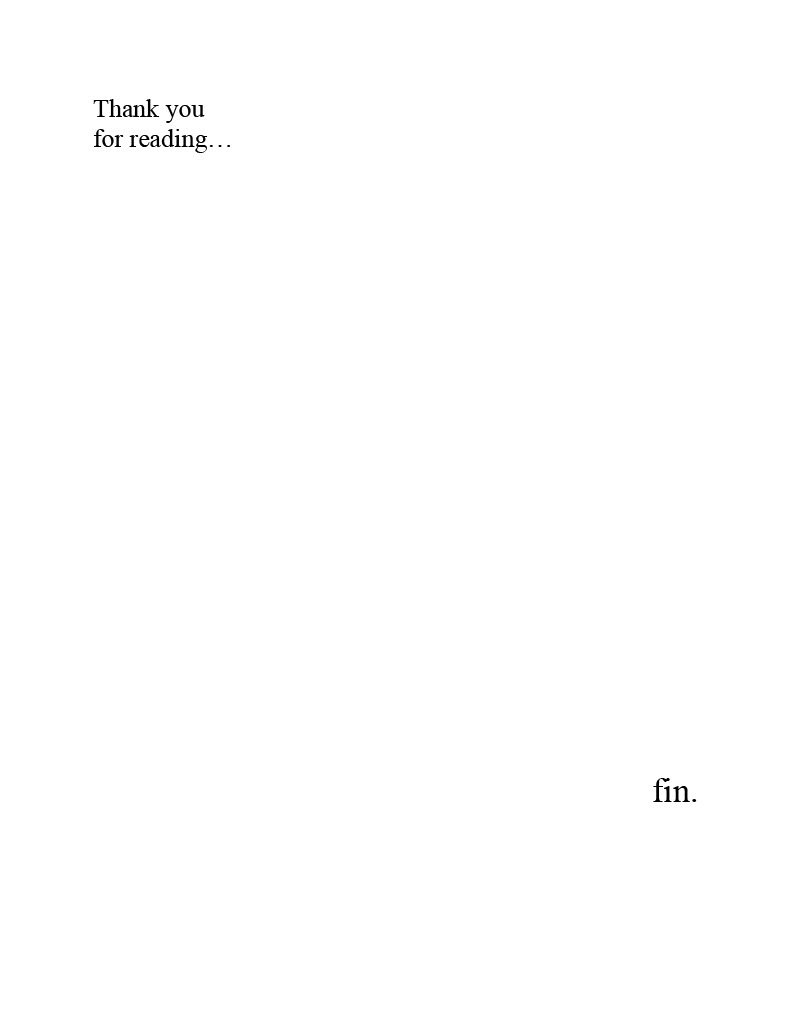A final year assessment for a special studies course on Innovations in Poetry and Prose, consists of twenty poems exploring ranges of poetic techniques to further expression. From sound poetry’s vocal incantations or surrealist’s stream of consciousness, each technique is purposeful.
May 4th, 2024
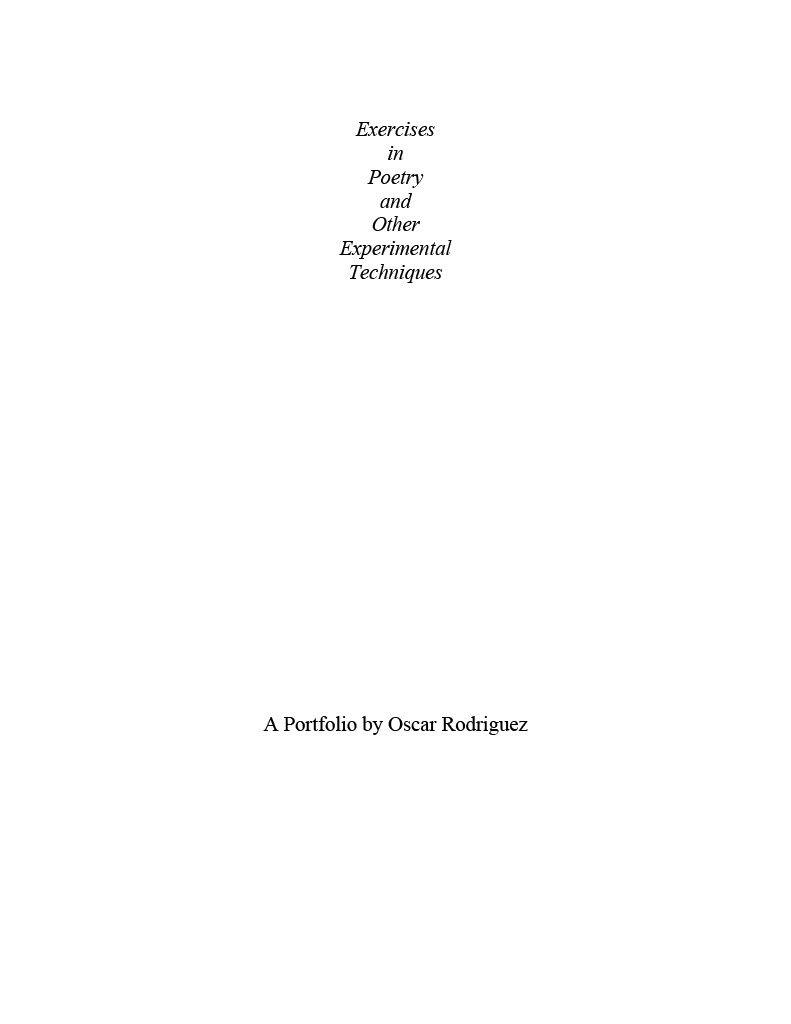

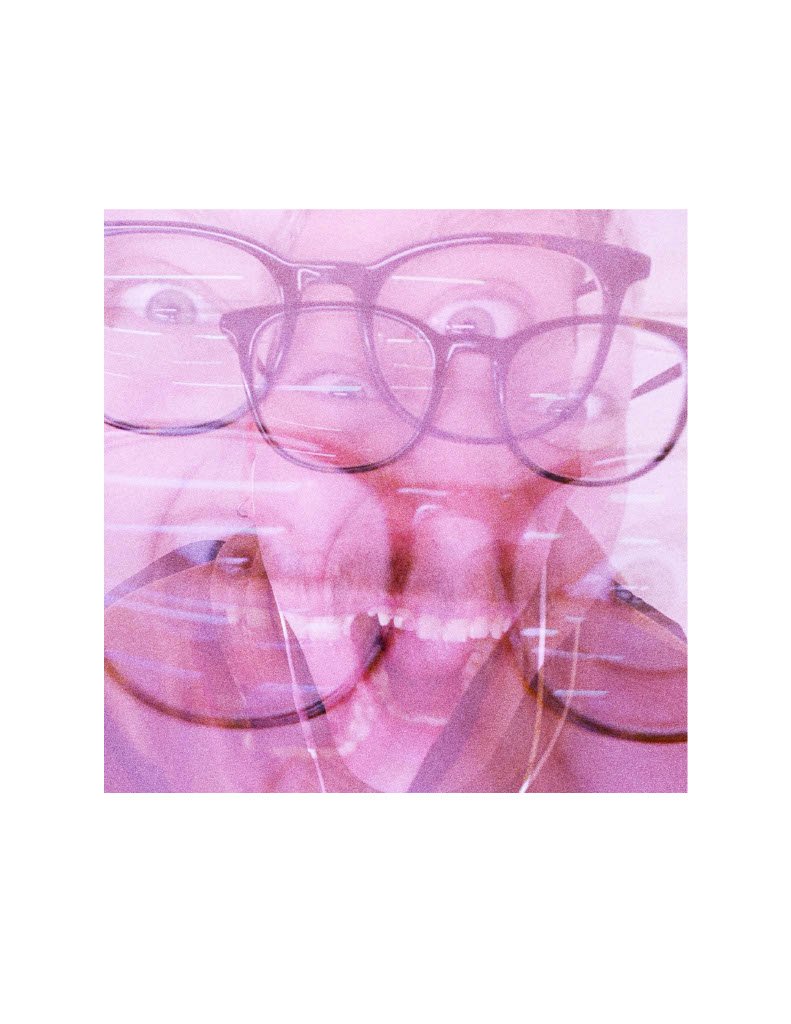
'WHERERU?': https://t.ly/QC5O- A sound poem using heavily edited vocals and instrumentals. With an endless possibility to sound, I chose a route of heavy distortion and instrumentals to power this piece. Through repetition of verse flittered through the song, it builds with grating chords pulling at the wrong notes. The use of non-language sounds such as groans and heavy breathing, add to its uneasy ambience. I combine this sound with title and photo cover, as the medium (Soundcloud) asks for it and for its added context on the song. A great introduction to editing and structure, than in randomness.
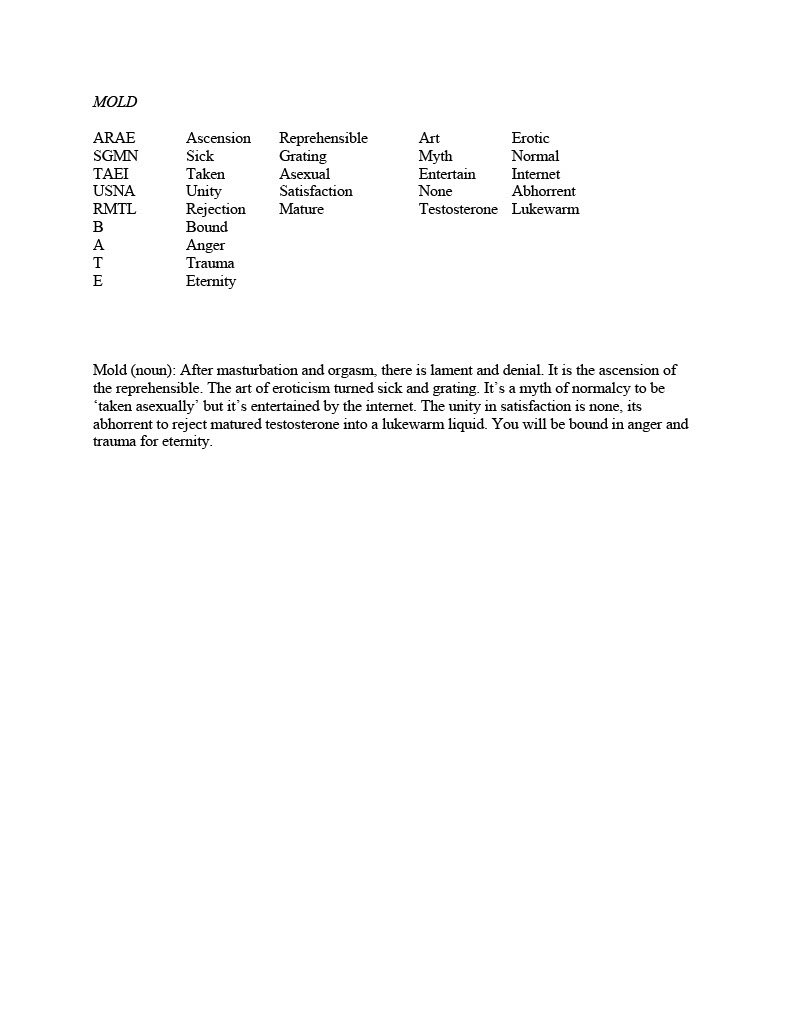
'MOLD': Constraint poem using a technique known as an analytic dictionary definition. Inspired by the French group of mathematicians, scientists, and writers, known as OuLiPo, I took empowerment in using constraints of structures, patterns, and games to explore writing. In this technique, an analytic dictionary definition, I began with selecting a four-letter word (Mold) and then vertically writing longer words from it. Then horizontally, each of the letters will begin a new word. The definition is then written from reading the first four vertical words which are then followed by horizontally reading the list of words created earlier. The outcome has peculiarity but a semblance of unity through vocabulary related to the theme of sexual promiscuity.
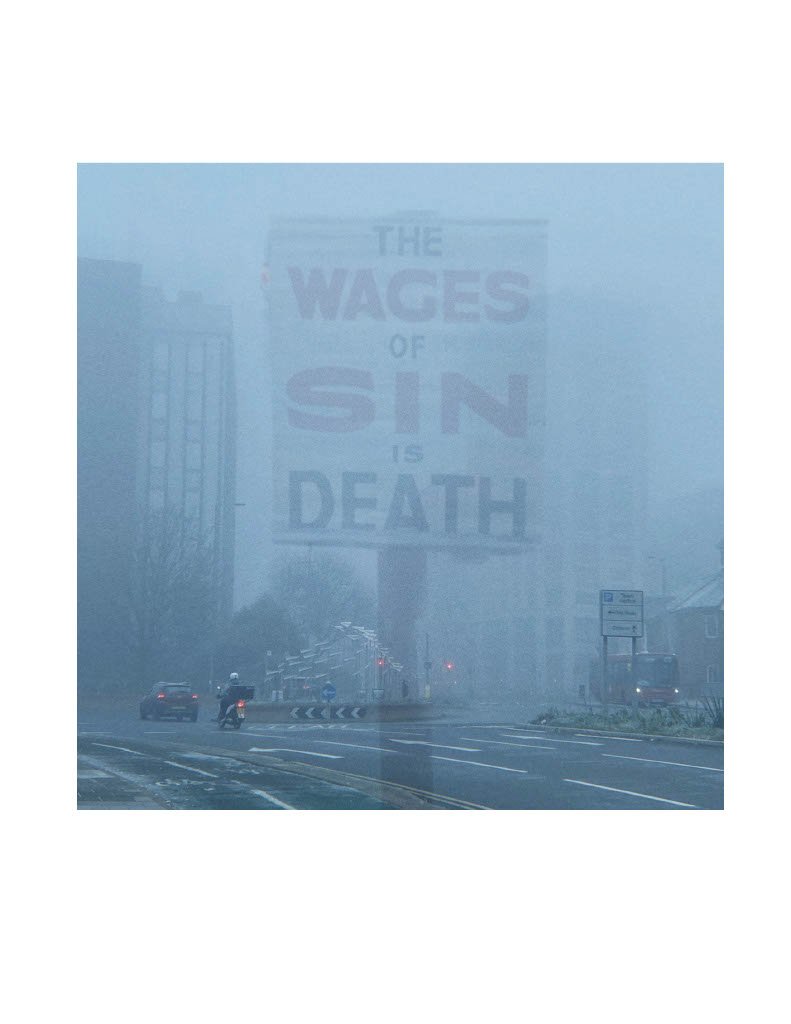
'Three': A photo poem, an image with an overlay of a sign. On this foggy day, there was a feeling of dread which was then confirmed by a preacher screaming in the high street. As an ex-Jehovah’s Witness, the correlation between the harmless fog by the motorway and the bold warning sign seemed to speak on modern society. I grew up believing that sin was inherent to these concrete buildings and people; a sign of humanism that God had never approved. With the sign set in the middle, taller and bigger than the buildings behind it, it is a warning on the tax on all of us.

‘A prowler by night.’: An art poem using an erasure technique, article taken from Animal Life of the World, 1934. This piece relies on its composition to convey an aesthetic text, with its green strokes across the words and a lighter background. The separated boxes of image and text add design to this erasure piece, with words still left to create a disfigured sense of the ‘prowler’ in the image below. I didn’t want to remove the monkey from its context, which is why I left words such as Douroucoulis or the uakaris. The monkey is sensitive, just look into his eyes.
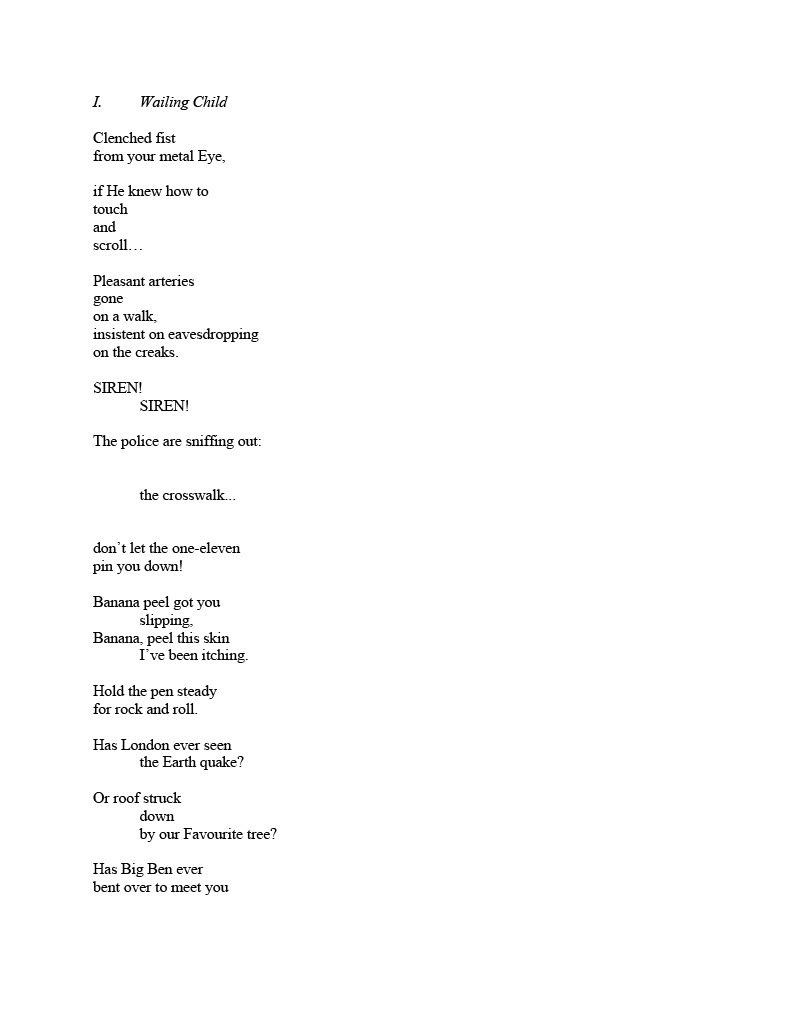
'I, II, III': Surrealist, psychogeography, stream of consciousness while on a walk. As an avid walker, I use psychogeography to explore how one relates to and constructs space. With a surrealist technique of stream of consciousness, I fully observe my environment and my emotions that reflect the space. This poem is separated into three parts to highlight the change in scenery and structure. As I traverse from the bus to Woodland Gardens, and back to a bus stop, I start with ‘Wailing child’ with indentations and blank space. ‘Decay’s Hue’ imagery shifts to the natural with a repetition of question, which brings us to ‘Thames Street’ which brings back imagery of civilization.
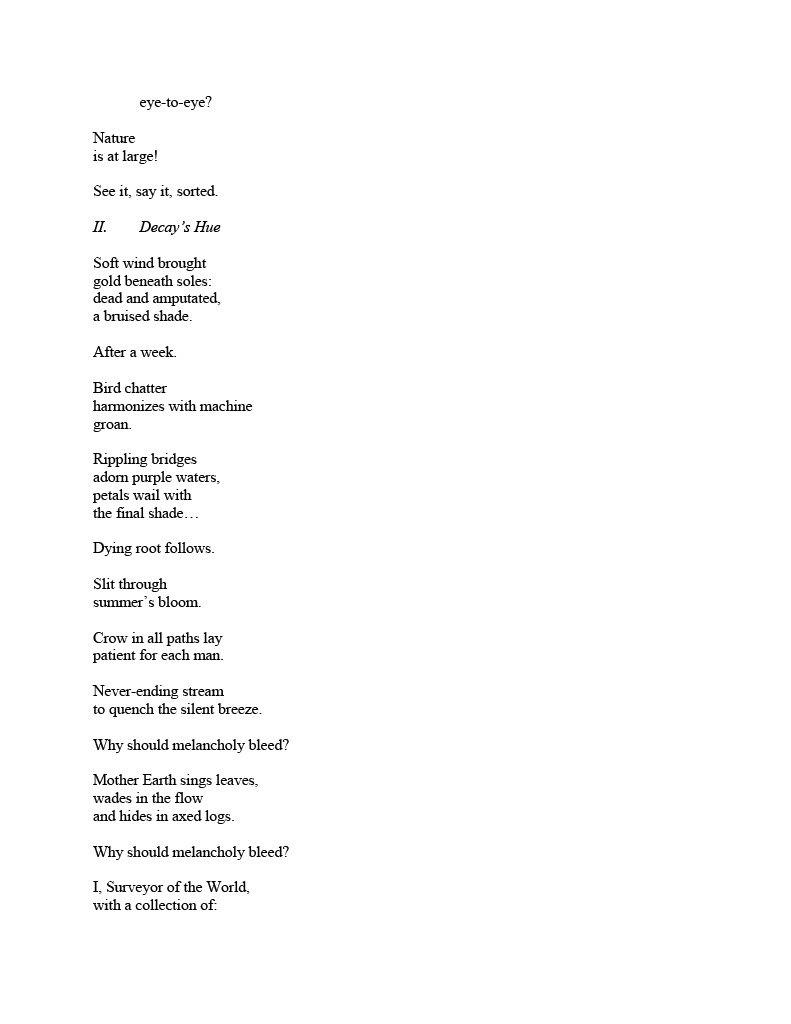
'I, II, III': Surrealist, psychogeography, stream of consciousness while on a walk. As an avid walker, I use psychogeography to explore how one relates to and constructs space. With a surrealist technique of stream of consciousness, I fully observe my environment and my emotions that reflect the space. This poem is separated into three parts to highlight the change in scenery and structure. As I traverse from the bus to Woodland Gardens, and back to a bus stop, I start with ‘Wailing child’ with indentations and blank space. ‘Decay’s Hue’ imagery shifts to the natural with a repetition of question, which brings us to ‘Thames Street’ which brings back imagery of civilization.
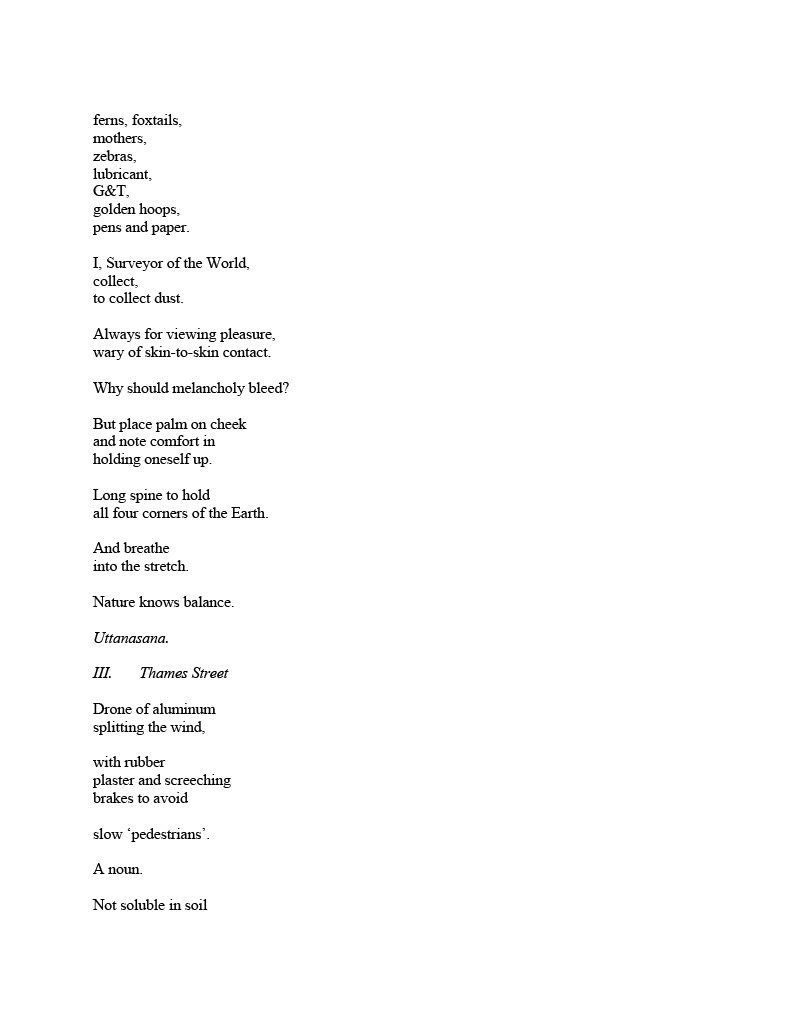
'I, II, III': Surrealist, psychogeography, stream of consciousness while on a walk. As an avid walker, I use psychogeography to explore how one relates to and constructs space. With a surrealist technique of stream of consciousness, I fully observe my environment and my emotions that reflect the space. This poem is separated into three parts to highlight the change in scenery and structure. As I traverse from the bus to Woodland Gardens, and back to a bus stop, I start with ‘Wailing child’ with indentations and blank space. ‘Decay’s Hue’ imagery shifts to the natural with a repetition of question, which brings us to ‘Thames Street’ which brings back imagery of civilization.
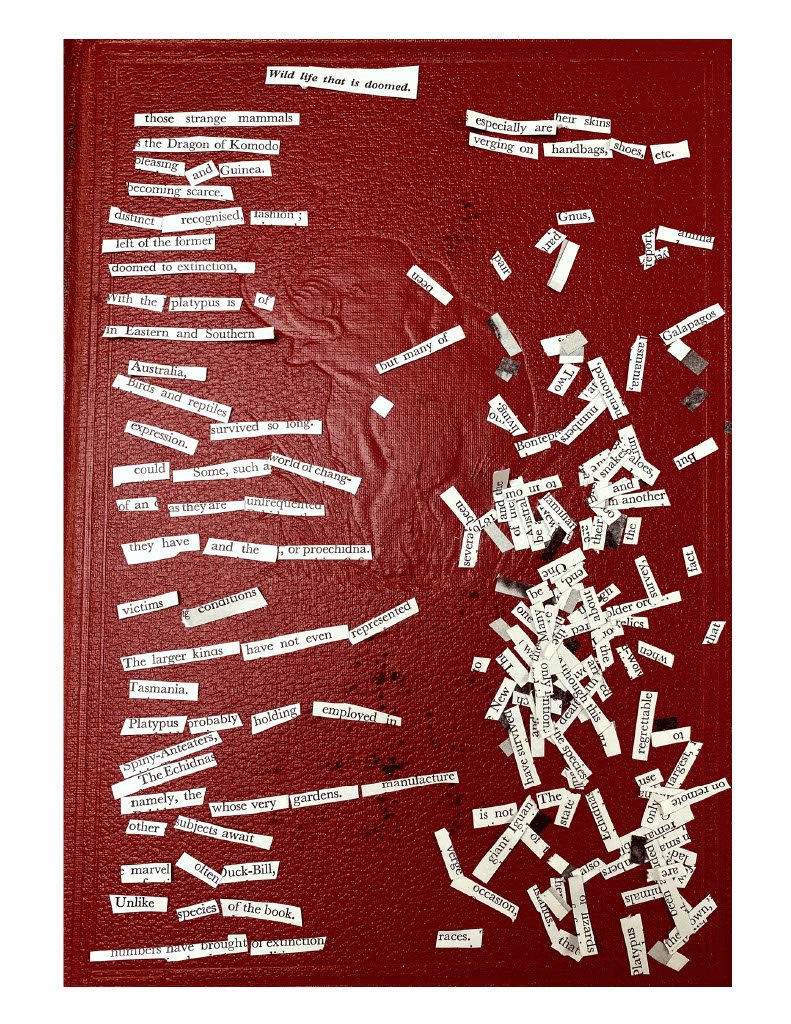
‘Wild life that is doomed.’: Dada cutout photo poem of an article from Animal Life of the World, 1934. Dada presents us with chance; an opportunity for the nonsensical. With this technique of cutout poetry, it bring it to full effect. To source the material, I chose an article on animal extinctions from 1934. To breathe a new perception of it, I chose the cutout methods of line breaks and picking them at random. The poem created has confusing grammar, incoherent lines an even a Platypus holding employment. This piece brings light humor onto a dark subject, and the photo acts as a great way to perceive it. With scrambled text to the side, it has rich texture with an elephant stepping out of the book.
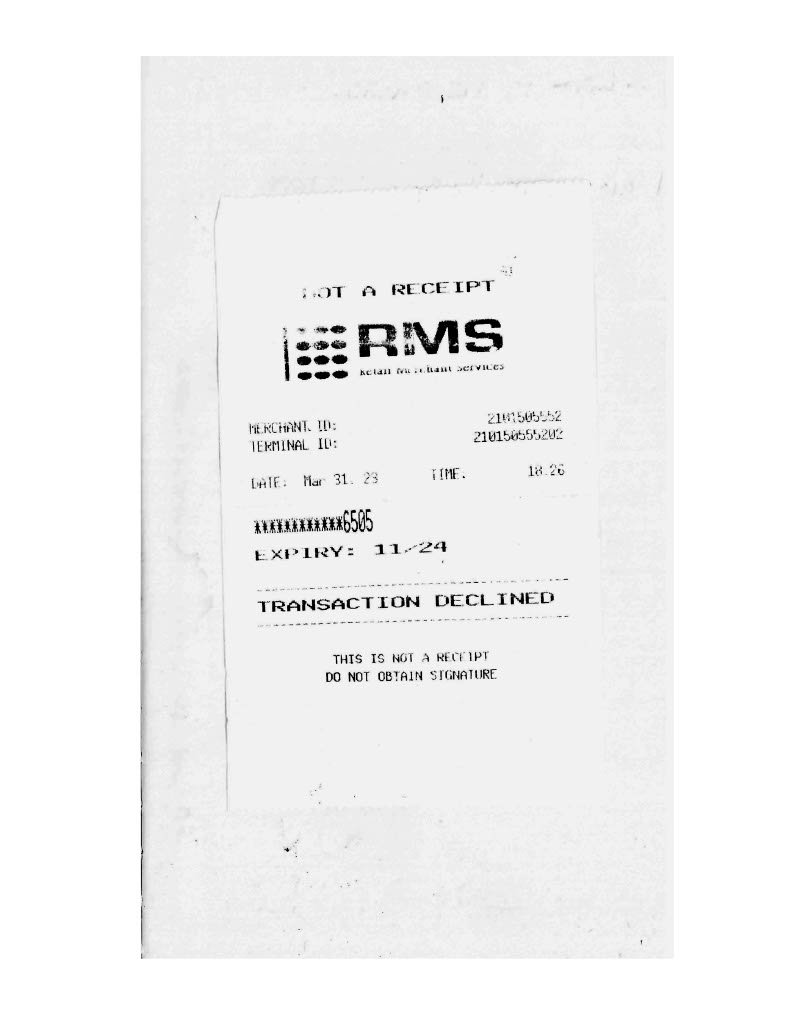
'Declined': A conceptual poem of a scanned transaction receipt, glued on paper. In conceptualism, the context is key in transmitting the weight of a piece. This is taken out of a daily diary, where I’d collage pieces of text I found. This day carried a heavy weight of depression and an arduous shift at work. It was there where I pocketed a declined receipt as I found it reflective of the moment. The faded letters of ‘NOT A RECEIPT’ create a juxtaposition between what this item is, and what it claims to be. Glued onto a page with nothing else, the wide margins and centred positioning allows it to speak for itself.

'Grindddr': Concrete poem using only words from Grindr’s interest section. The visual and semantic convey meaning through its typographical effect. In this piece, I began with the word ‘Mold’ and extracted words from Grindr’s interest section. The background for this piece adds decomposing texture which evoke the word’s deeper context. In a hedonistic culture such as Grindr’s, this Scrabble-like game connects the two with the grotesque deterioration of sexual freedom.

'Spiral': Asemic writing, charcoal and ink on paper, later inverted. Absent of semantics and open to abstract gestures of language, asemic poetry is communication through the indecipherable. It relies on the evocation of feeling, the cursive like writing conveys speed as the spiral falls into its centre. The charcoal adds rich texture compared to the ink’s smooth lines, a distinct separation between the two. The black space is heavier, as if looking into sky in search of comets, only to find a spiral of alien movement.
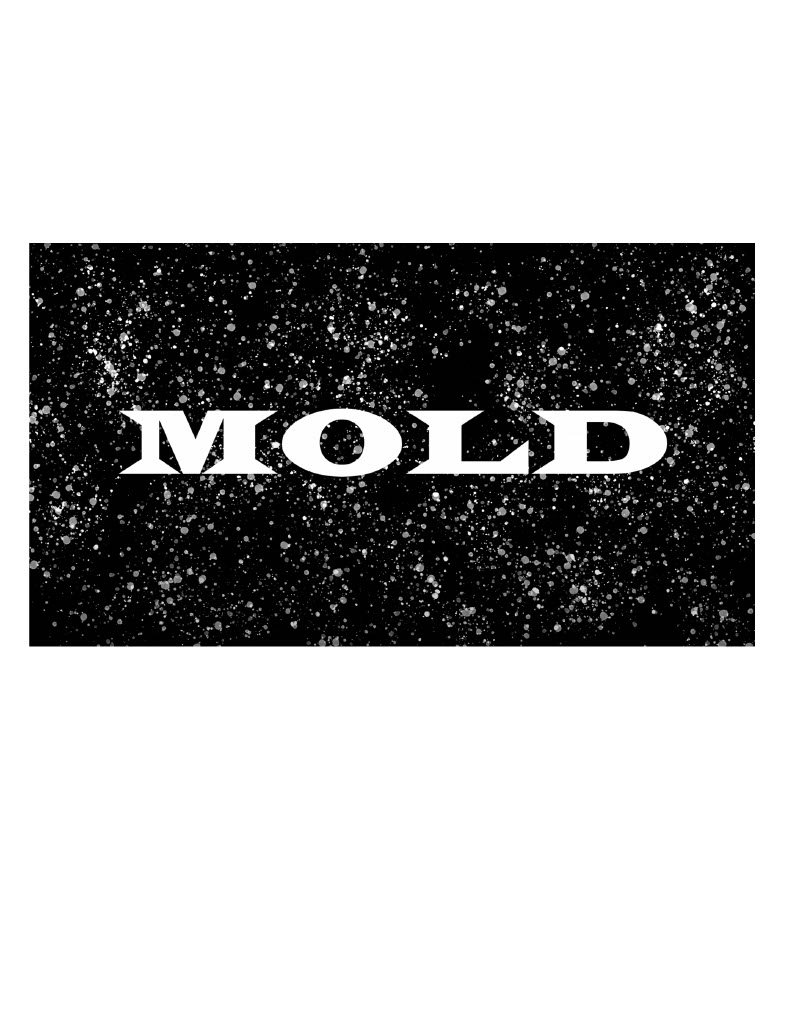
'MOLD: A Live Hypnosis': https://t.ly/kqxyH A film poem based on my ‘MOLD’ pamphlet, using visual and audio simulations. Spanning half an hour, this film poem uses visual and audio techniques to guide the viewer in the descent of sexual addiction. Through visual simulations of mold ever growing with a soundtrack building suspense and doom, MOLD: A Live Hypnosis attempts to simulate the mind. Interrupted by hypnotic trances, flashing lights, this piece uses a range of techniques from constraint to text art, and the conceptual idea of a breakdown unfolding in front of your eyes.
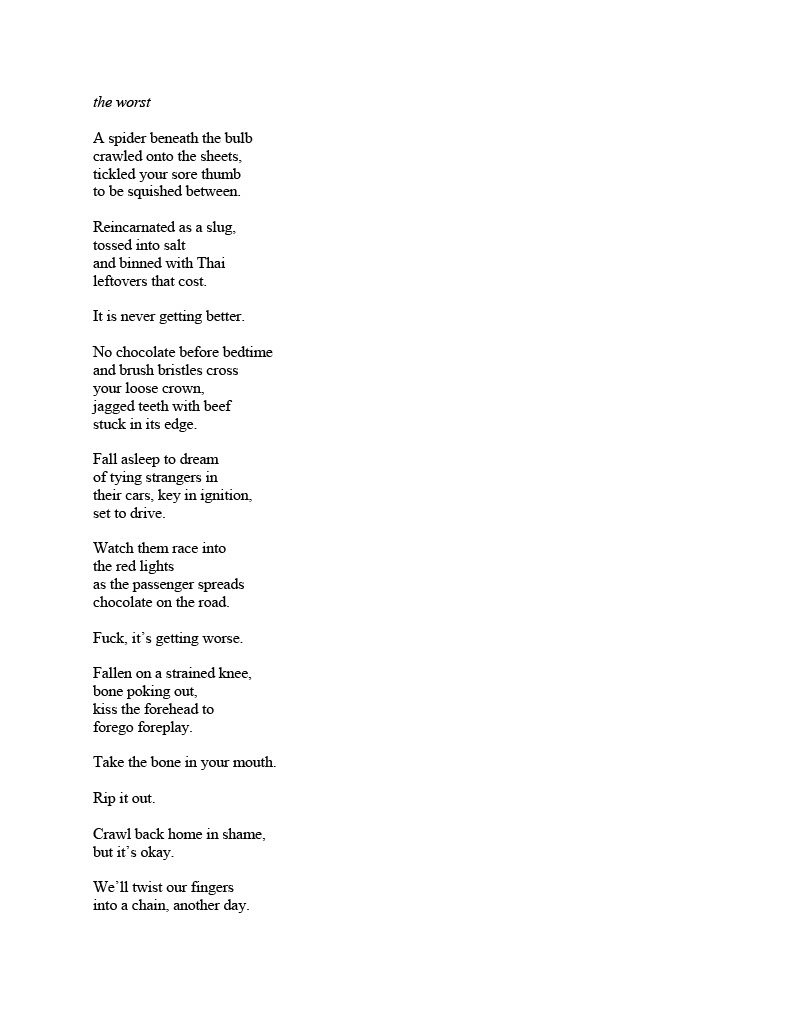
'the worst': Surrealist poem, stream of consciousness, reflecting on a dream. Empowered by stream of consciousness, ‘the worst’ extracts a dream’s illogical imagery to represent a failing mind. Succumbing to dreams that aren’t far from reality’s sense of dread, there is quick movement between each stanza. Moving from a spider to a slug to teeth with beef, the imagery grounds itself with the repetition of fear. “It’s never getting better to “There is no recovering,” pull the reader away from the chain of dreams, into reality.
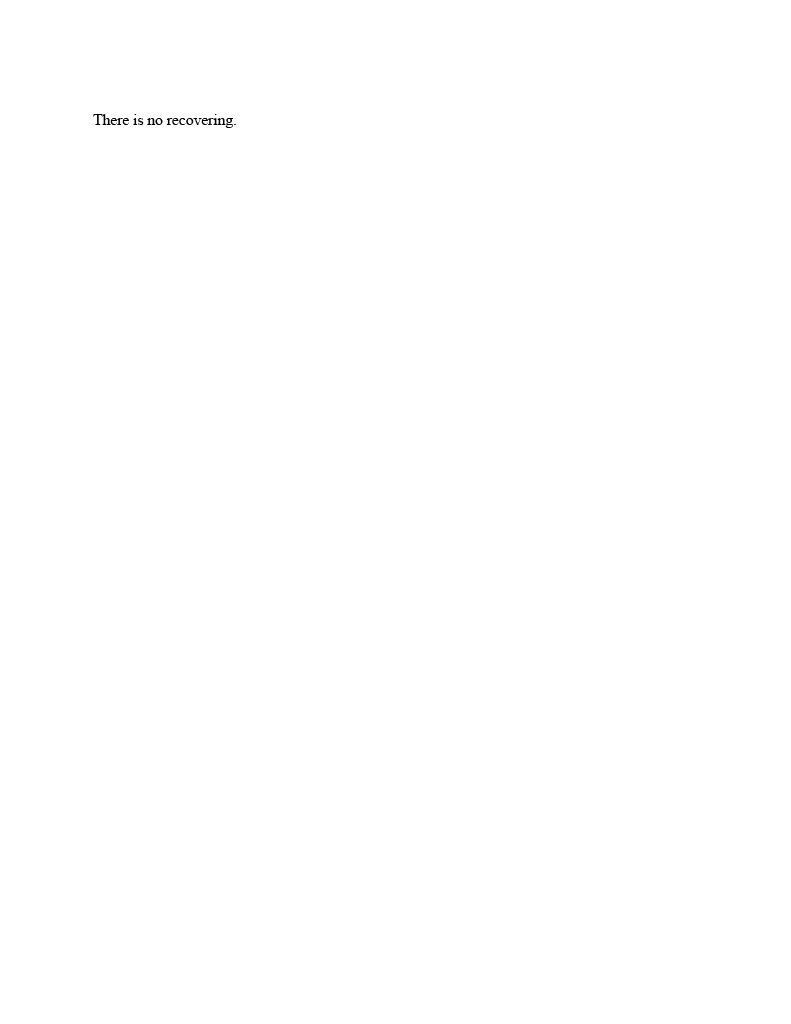
'the worst': Surrealist poem, stream of consciousness, reflecting on a dream. Empowered by stream of consciousness, ‘the worst’ extracts a dream’s illogical imagery to represent a failing mind. Succumbing to dreams that aren’t far from reality’s sense of dread, there is quick movement between each stanza. Moving from a spider to a slug to teeth with beef, the imagery grounds itself with the repetition of fear. “It’s never getting better to “There is no recovering,” pull the reader away from the chain of dreams, into reality.
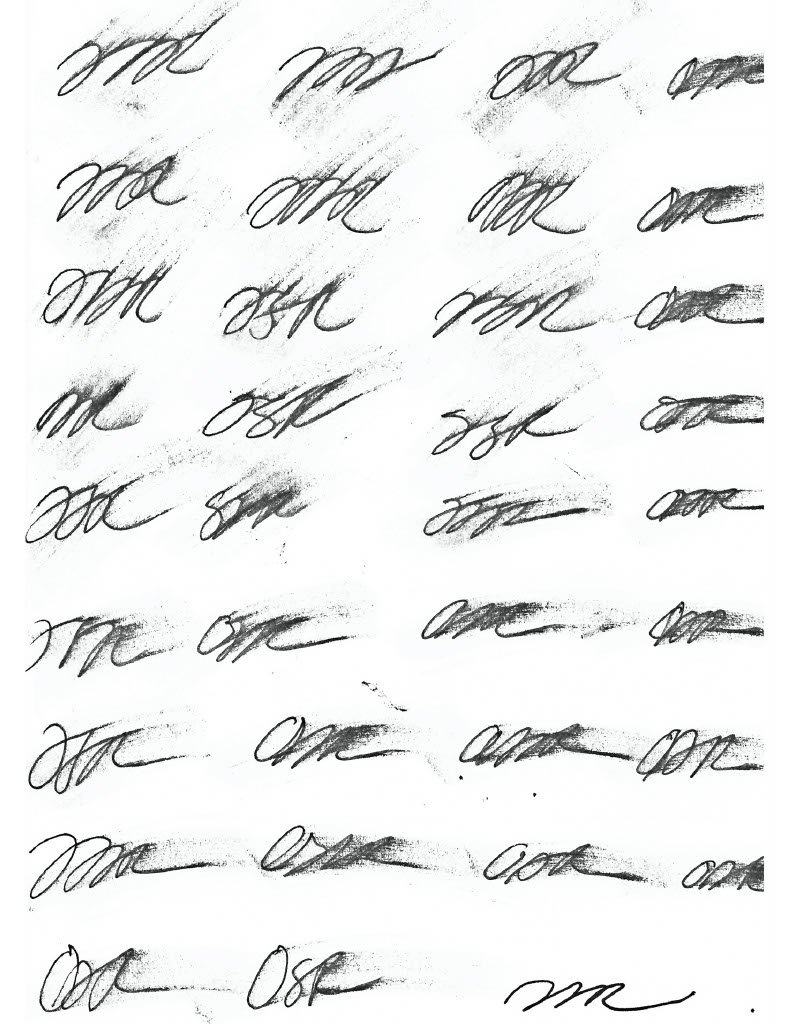
'Forged': Asemic writing done with ink on paper. A signature seems unique to people, but with enough practice a forged signature could bring havoc. With this asemic piece, I had to enter a flow state of disarming my hand from head. Through its repetitive nature, I began smudging the ink before it dried with every signature. This gives the piece a shadow effect which evokes attempts at faking it. With only one signature not smudged in the corner, it’s a piece on revelations of true identity.
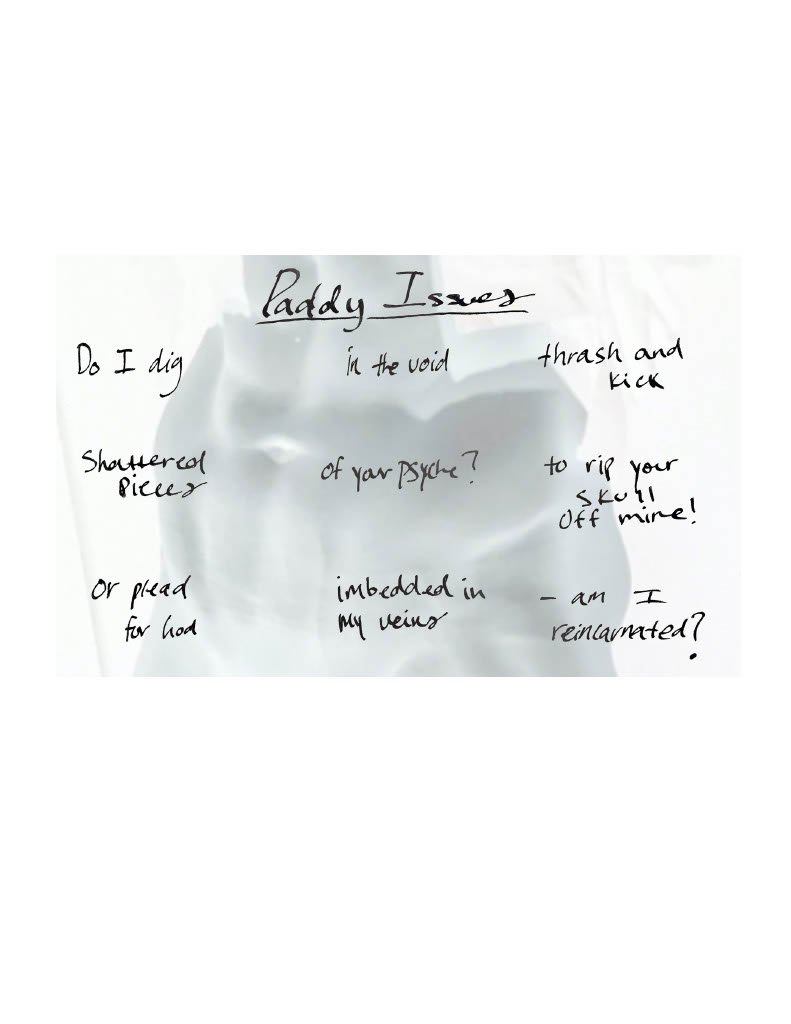
'Daddy Issues': A photo poem using a constraint poem. An exercise in calligraphy, handwritten text is key to relationship with the photography. Gently scrawled over a toned abdomen, the text is self-aware of its sexual nature. The photo is inverted and over exposed to create a clearer background for the text to appear on. This effect also creates dissonance between the body and text, allowing the words to be of focus. The constraint technique is inspired from the OuLiPo Compendium, in which the poem’s stanzas can be read vertically or horizontally. This creates two readings of the same piece, with varying abstract sentences both ways.
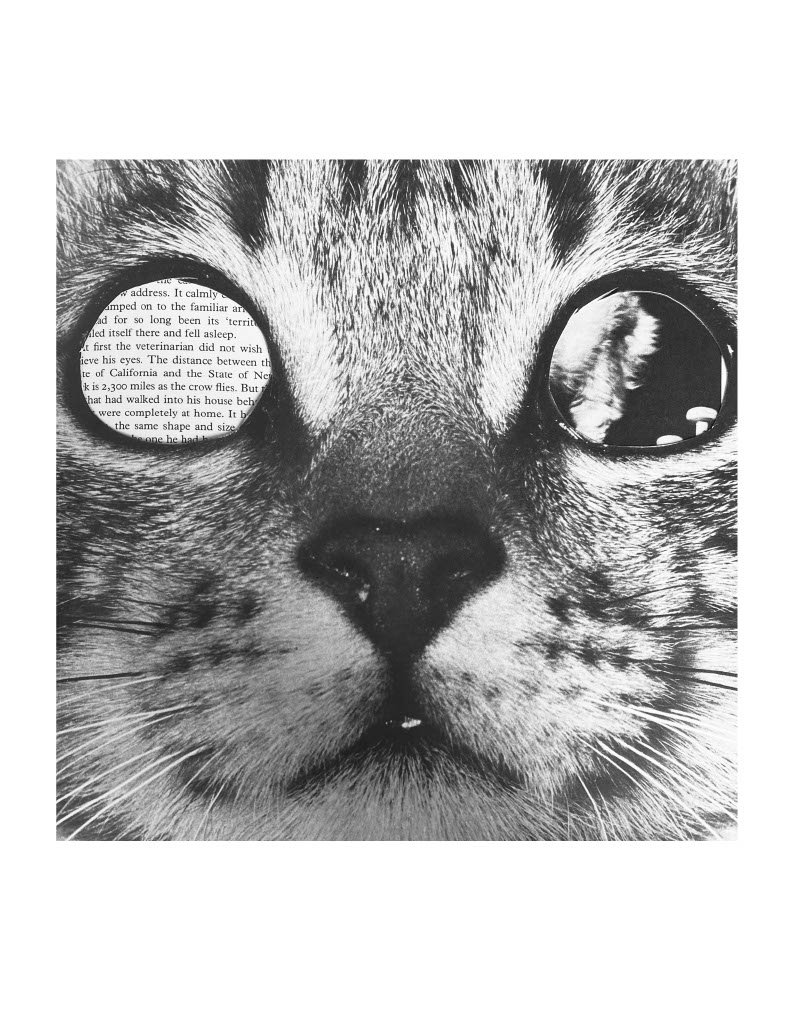
'ICU': An art poem using a reveal technique. Taken from a book of cats, this collage technique reveals instead of erases text. Through removing the cat’s eyes, it creates a balanced composition and a compelling uneasiness. The text’s small font hides in the big image, while the other eye holds nothing of resemblance. This contrast of a black and white eye, create an art poem focused on design than text.
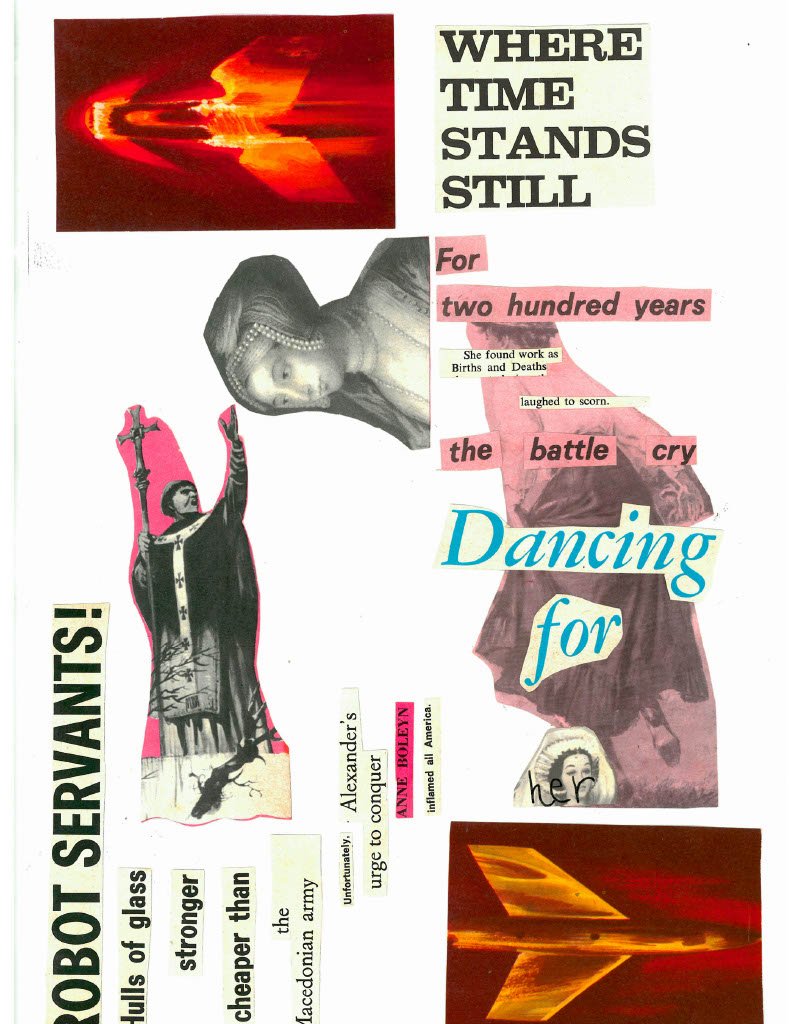
'Dancing for Anne': A collage poem using text and visuals from Look and Learn, 1969. Following a surrealist take on collage poetry, these fragments are taken from a range of articles. These join on the page to contrast and begin conversation between each other’s text and images. On the left, stands Alexander the Great with bold black text positioned horizontally against the right. Anne Boleyn’s head lays next to the text taken from a Women’s Suffrage article, vertically upright on top of a dancing woman. The contrast between masculine and feminine ideals is demonstrated through composition, font, and images.
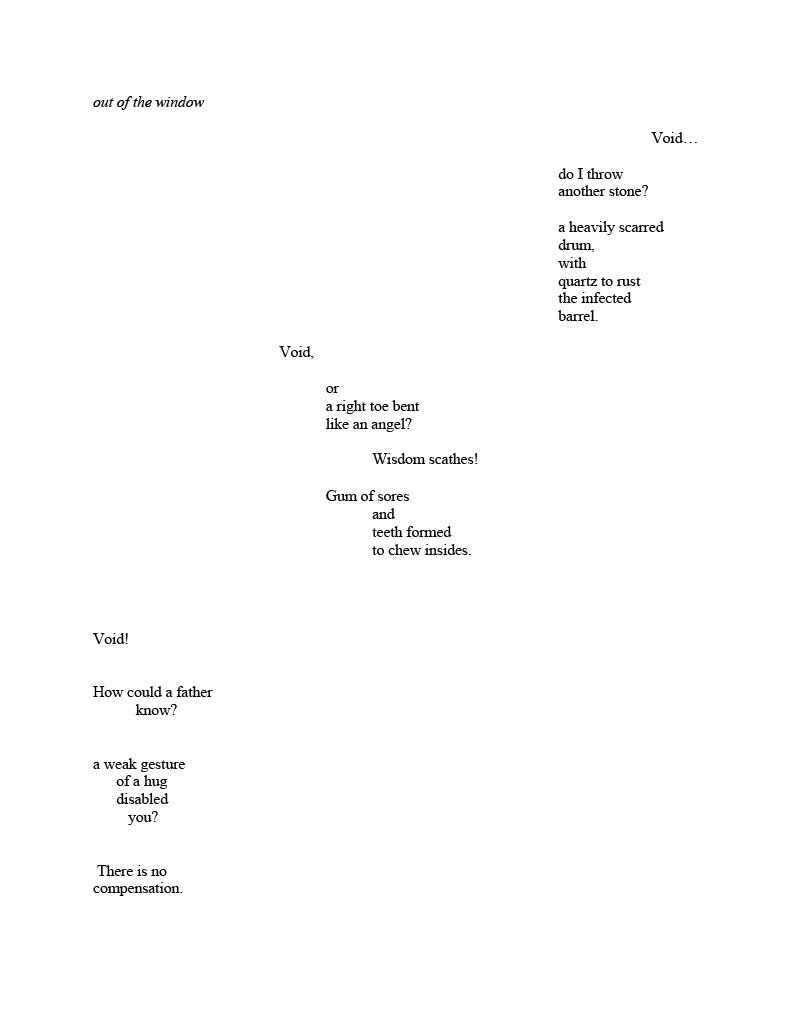
'out of the window': A concrete poem, with language poetry influences. Like rocks thrown out of a window, the stanzas cascade down in a zigzag with space acting as the air they fall in. The composition here is simple as to let the words carry own their weight. The short lines are quipped in sombre yet disjointed imagery, in speaking directly to the ‘Void’. Such as a right toe bent like an angel; this emphasises the reader in creating a meaning.

'out of the window': A concrete poem, with language poetry influences. Like rocks thrown out of a window, the stanzas cascade down in a zigzag with space acting as the air they fall in. The composition here is simple as to let the words carry own their weight. The short lines are quipped in sombre yet disjointed imagery, in speaking directly to the ‘Void’. Such as a right toe bent like an angel; this emphasises the reader in creating a meaning.
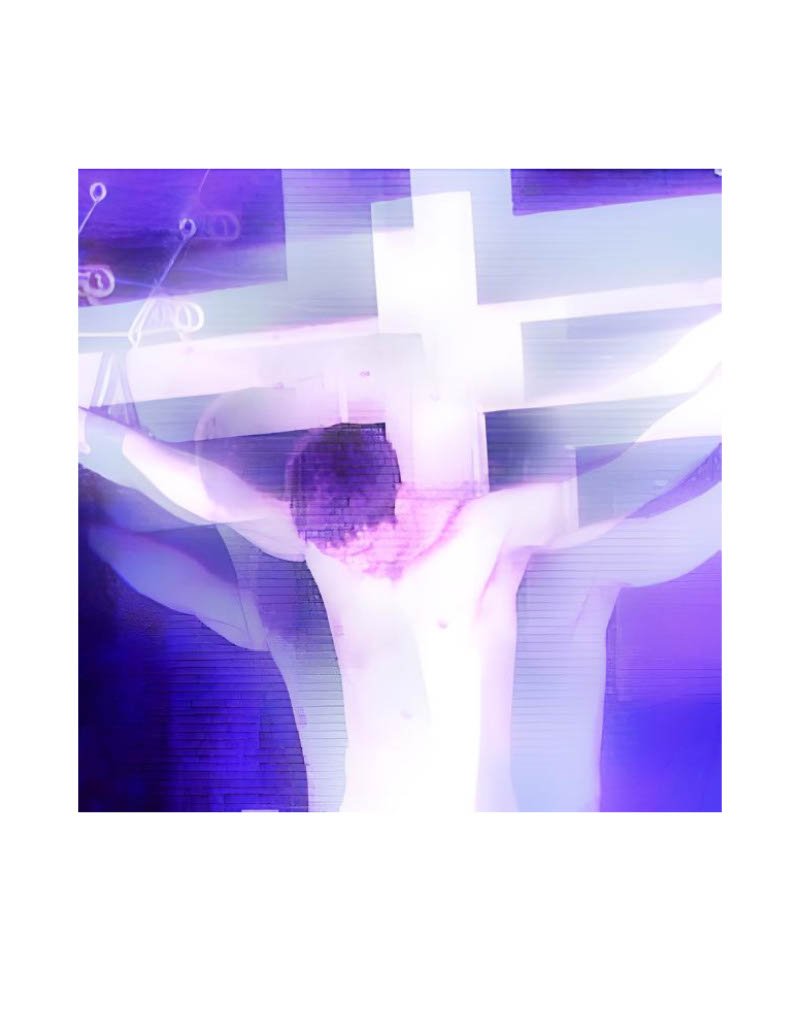
'Adam is an Addict: A Sermon in the Underground': https://t.ly/r1fEt A sound poem using synth organ and heavy distortion. To explore this sonnet’s blasphemous lines, I created a soundscape that uses distorted vocals to create distance and depth. I sonnet form I chose repeats each final word in a six-stanza breakdown. With a performance of a fervent preacher, the words are furious with an added choir and dooming organ as setting. It builds and builds, ending with a indecipherable reversed vocal that leaves the listener haunted.

'Last Night’s Tension': An art poem using charcoal, burnt text and pen. I engage the image and text together to communicate a whole expression. Beginning with a burnt page glued on the page, the scratched writing warps around its centre. These words are half covered by charcoal to demonstrate the hastiness of this work, the speed of which the emotion of despair hits the page. The centre is devoid of text, only rubbed in with charcoal that doesn’t leave it black but with a jagged texture and frayed edges, it culminates in evoking loss.
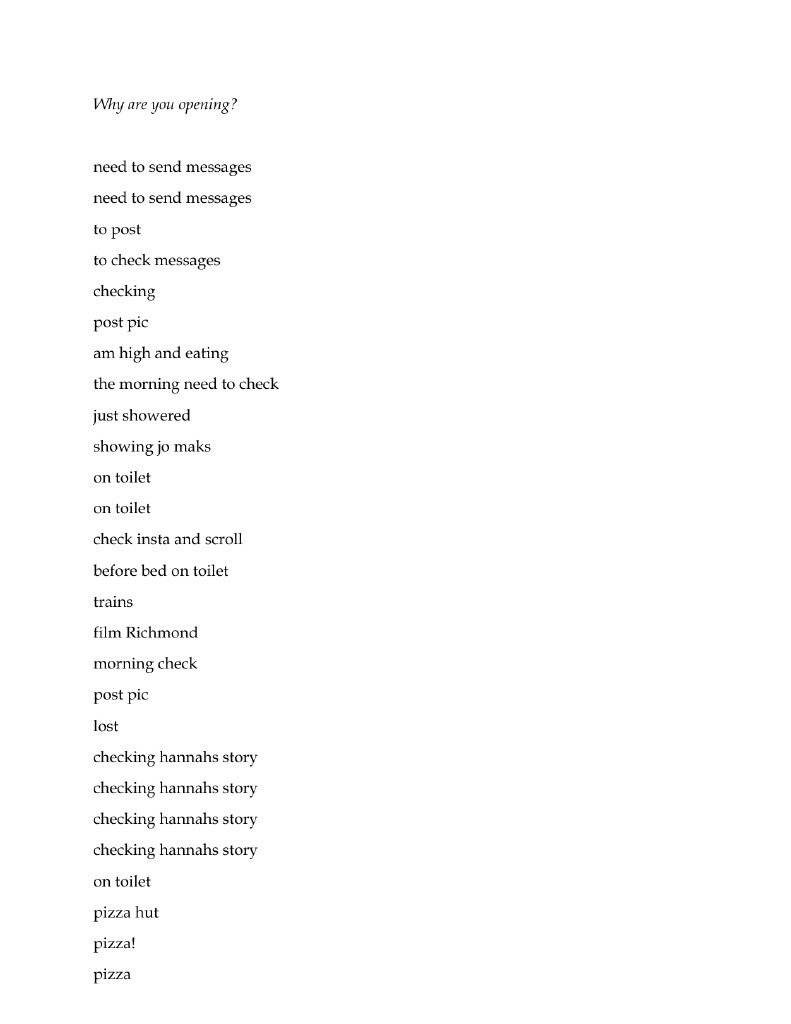
'Why are you opening?': https://t.ly/K16pJ A conceptual kinetic poem consisting of log in reasons (see link for GIF). In an effort to lower my screen time and social media consumption, I installed software that would force me to reconsider my use of them. To open an app, I would be asked, “Why are you opening?’ to which I would insert a valid reason. Unfortunately, putting in a sentence every time is an effort, so ‘meow’ became my valid reason among other phrases. Still, my screen time has lessened, and I’ve created a GIF from all my reasons. This format works best as it reminiscent of scrolling and collates over 20 pages, lessening the weight of the words but allowing the reader to understand the greater context.
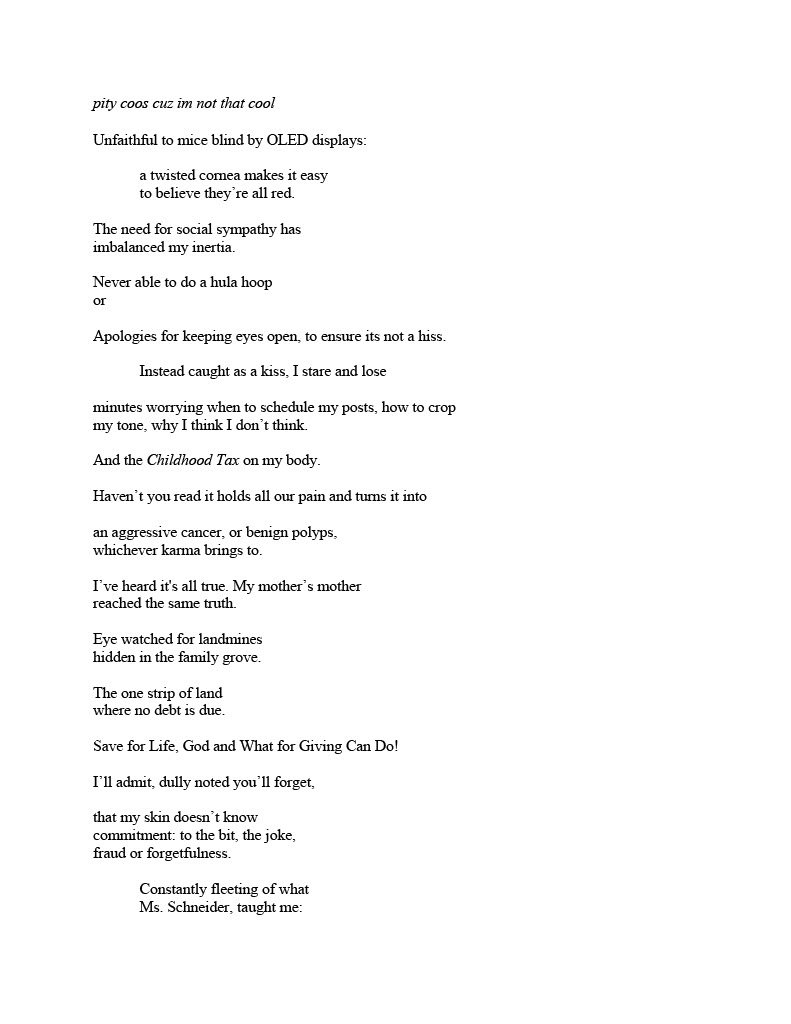
'pity coos cuz im not that cool': A New York school-style poem. This piece blossoms in prose that uses everyday language to create a confusing yet recognizable texture. I use pop culture references of an ‘Instapoet’ and ‘gay-and-talented’ adhere to a personal account of imposter syndrome while poking fun at the irony of performativity on being a poet. The form and structure changes through the piece, with no solid rhyming pattern or meter. Contrasting from a confessional poem, I infuse the piece with witty phrases and fragments of world view, to create an intimate piece responding to the contemporary worries of commodification.
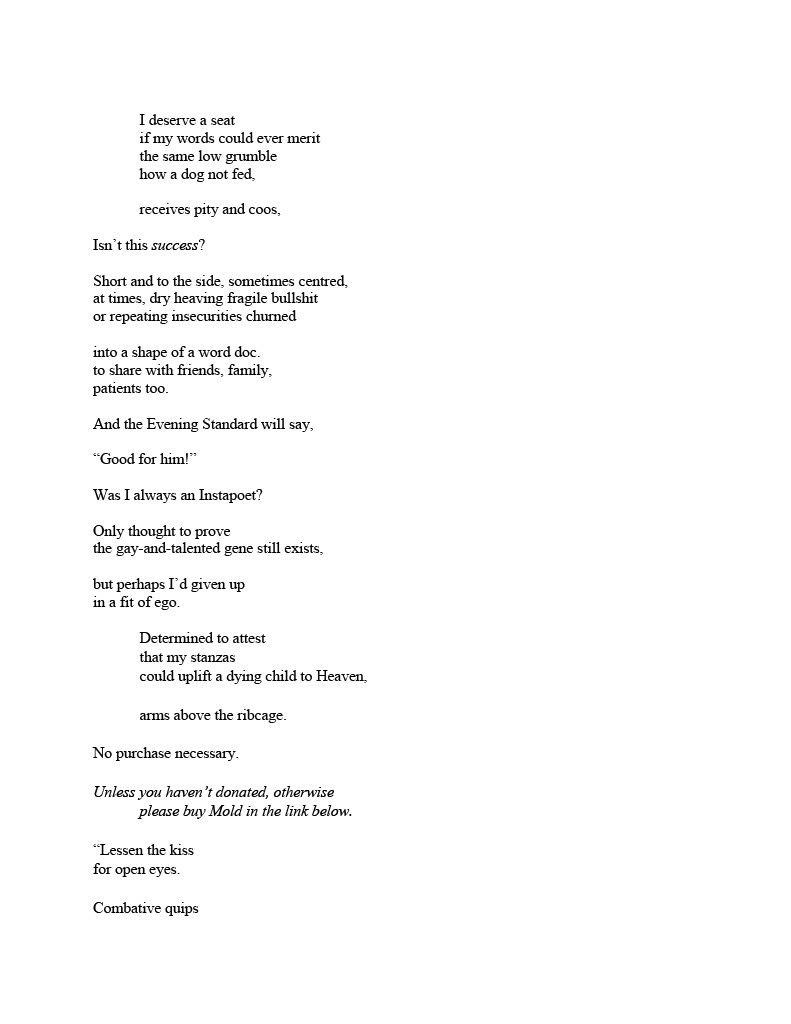
'pity coos cuz im not that cool': A New York school-style poem. This piece blossoms in prose that uses everyday language to create a confusing yet recognizable texture. I use pop culture references of an ‘Instapoet’ and ‘gay-and-talented’ adhere to a personal account of imposter syndrome while poking fun at the irony of performativity on being a poet. The form and structure changes through the piece, with no solid rhyming pattern or meter. Contrasting from a confessional poem, I infuse the piece with witty phrases and fragments of world view, to create an intimate piece responding to the contemporary worries of commodification.

'pity coos cuz im not that cool': A New York school-style poem. This piece blossoms in prose that uses everyday language to create a confusing yet recognizable texture. I use pop culture references of an ‘Instapoet’ and ‘gay-and-talented’ adhere to a personal account of imposter syndrome while poking fun at the irony of performativity on being a poet. The form and structure changes through the piece, with no solid rhyming pattern or meter. Contrasting from a confessional poem, I infuse the piece with witty phrases and fragments of world view, to create an intimate piece responding to the contemporary worries of commodification.
